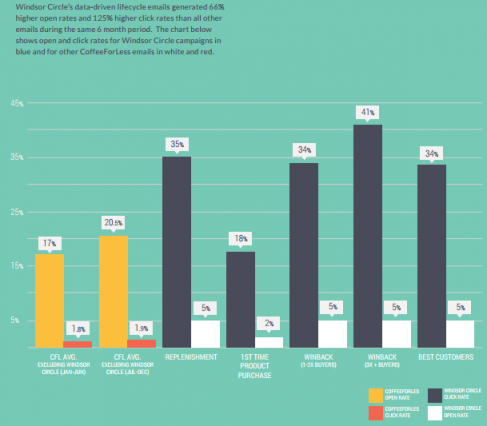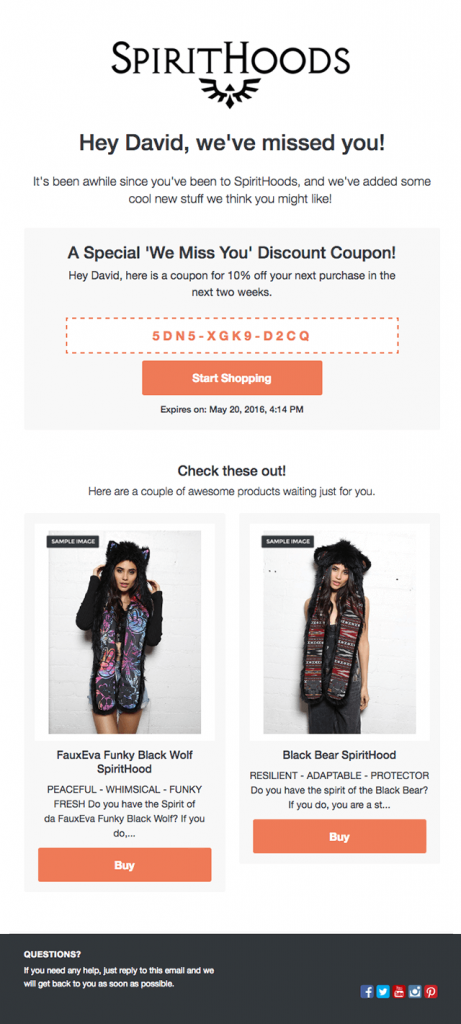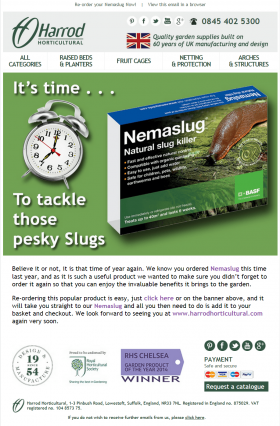A common mistake ecommerce store owners make is accepting the sale as the end-goal. It is easy for brands to think in such a transactional way; looking beyond each purchase can prove challenging.
A 2014 survey by Econsultancy revealed, “Just 42% of companies are able to measure customer lifetime value.” Though the remaining 58% understand the importance of customer loyalty and retention, they may find it difficult to execute and analyze customer happiness and conversion campaigns.
For a business to thrive, it must provide customers with long-term value that translates into repeat purchases and, thus, increases the customer’s lifetime value to the company.
And that is where carefully crafted post-purchase emails come in.
Table of contents
The ROI of Post-Purchase Emails
Post-purchase emails should have a primary goal of improving the customer experience, whether it’s an order confirmation email to give shoppers peace of mind, a product information email to educate users on how to extract the most value out of their purchase or a replenishment reminder that gently encourages repeat purchases.
Of course, an incidental benefit from well-designed post-purchase emails is a boost to customer satisfaction and sales.
The Research Says…
Research from customer experience firm Medallia published in the Harvard Business Review states, “Customers who had the best past experiences spend 140% more compared to those who had the poorest past experience.”
And follow-up emails help facilitate positive brand sentiment which, in turn, leads to more sales.
Broad data about email marketing reinforces the fact that it is an effective and powerful medium for customer engagement. The Direct Marketing Association’s (DMA) 2015 National client email report tells, “Email has an average ROI of $38 for each $1 spent.”
In one case study, retention marketing software firm Windsor Circle shared how much one of its clients benefitted from strategic post-purchase emails.
CoffeeForLess made over $500,000 in 6 months from data-driven lifecycle marketing powered by Windsor Circle. These emails had 66% higher open rates and 125% higher click rates compared to their average rates for the same time period.
Here’s the data…
Using a mixture of product recommendations emails, replenishment reminders, win-back campaigns, and reward offers, CoffeeForLess added more than half a million dollars to its nearly $19 million in sales.
Now, think about how you too can benefit from implementing a thoughtful post-purchase marketing strategy.
The Impact of Different Types of Follow-up Messaging
On January 3rd, 2017, MailChimp updated its email marketing benchmarks page after analyzing billions of monthly email sends across its user base of 14 million accounts. Under the ecommerce category, MailChimp reported an average open rate of 16.71% and an average click rate of 2.34%.
Last year, email marketing software provider GetResponse published its State of Email Marketing Report which shared similar results: with retail and ecommerce grouped together, the analysis revealed an average 16.78% open rate and a 3.07% click rate.
In IBM Marketing Cloud’s 2016 Email Marketing Metrics Benchmark Study we also see comparable stats. Among retail and ecommerce emails, the survey found an average open rate of 20.5% and a 3.5% click rate.
Of course, when we delve deeper into the impact of post-purchase emails, we see significantly higher engagement. This month at Conversio, we analyzed 12.1 million follow-up emails and 24.5 million digital receipts ecommerce stores sent through our all-in-one marketing dashboard during the full 2016 calendar year.
Overall, we noted:
- An average 40.5% open rate, a 6.4% click rate and a 0.7% conversion rate across all follow-up emails.
- An average 65.0% open rate, a 10.4% click rate and a 1.4% conversion rate across all digital receipts.
Here, we see that follow-up emails are twice as likely to be opened and clicked than the average ecommerce marketing email. Digital receipts have an open and click rate more than three times the average ecommerce email send.
Beyond the Typical…
Below, we explore how ecommerce marketers can leverage four under-utilized types of post-purchase correspondence to boost customer happiness and conversions.
Since most store owners already invest heavily in optimizing emails that include discounts, customer referral prompts and product feedback requests, we will skip over those here to focus more on post-purchase emails brands should add to their arsenal.
1. Digital Receipts & Order Confirmation Messages
When a shopper converts into a customer, the first email they expect from you is their order confirmation. Therefore, it is no surprise that we see so much engagement with the average receipt.
However, most stores squander this opportunity by plainly listing what the customer purchased, how much it cost and when they can expect to receive it.
At the National Retail Federation’s 2014 annual expo, Jack Dorsey, CEO of payments processor Square, asked the audience:
What if we see the receipt more as a publishing medium — a product unto itself that people actually want to take home, that they want to engage with, be fully interactive with?
What can we build into this canvas that’s actually valuable, that’s independent of the product you just sold? What can you give in this communication channel, this publishing medium, that people want to engage with?
All of you [store owners] give these receipts out by the thousands if not millions every single day — how do you make them viable unto themselves?
The answer, of course, takes into consideration the context of the purchase (a holiday sale, a gift for another recipient, an everyday item), the customer’s order history with your store and data you have gathered from other shoppers regarding their buying behaviors.
Five of the most engaging elements you can include within your receipts are:
- A unique discount code to facilitate repeat purchases.
- Recommendations for other products your customer may like.
- Incentives and prompts for your referral program.
- Social sharing buttons that either encourage customers to connect with you on their favorite channels or share their shopping experience with their friends.
- A request for customer feedback.
In fact, when we at Conversio compared plain receipts against those with any of the features above, we saw:
- Receipts without any additional marketing assets had a 61.7% open rate, a 5.1% click rate and a 0.1% conversion rate.
- Including just one of the five elements above (a discount code, product recommendations, a refer-a-friend prompt, social sharing elements, or a feedback request), on average, meant receipts saw up to a 14.6% increase in open rate, a 64.7% increase in click rate and a 2200% increase in conversion rate.
The revenue implications of a strategically crafted receipt are huge too.
When Food To Live, a family-run business that sells healthy, organic snacks and foods, decided to redesign and optimize its digital receipts, its receipts began driving an additional $12 in new revenue per send.
2. Product Education & FAQs
In 2015, OrderDynamics, a developer of omnichannel order management systems, commissioned advisory firm IHL Group to conduct a study that quantified the cost of product returns for retailers. Globally, the report estimates returns cost brands $642.6 billion a year.
Although returns may be free for many shoppers online, they are expensive for the stores receiving them. Data from Marketing Alternatives, Inc. states, “Returned items [cost] $12 a piece notwithstanding the cost of shipping, repair of damaged products and repackaging.”
And for some stores, returns have an even bigger impact on already-thin margins. Tony Hsieh, CEO of Zappos, wrote in an article for Harvard Business Review, “Our returns run high — more than a third of our gross revenue.”
Reducing the Cost of Returns
While Hsieh accepts his company’s high return rate as a necessary expense in delivering consumer happiness, other ecommerce brands can still strategically curb the cost of returns through product education and frequently asked questions (FAQs) in post-purchase emails.
WooCommerce’s Nicole Kohler recommends proactively sharing information customers may need to answer questions that arise after they complete their purchase. Kohler says:
You could put a mini FAQ right in your [marketing emails] to answer your [customers’] most common questions.
If you don’t want to take up that much space, you could simply link to your FAQ or customer support page where all of these questions are addressed.
This enables stores to turn what would otherwise be a negative purchasing experience into a positive one.
By sending information that helps your buyers better understand how to extract the most value from their order and lists all of its different use cases, you remove obstacles that may hinder their success with your product.
3. Product Recommendations & Cross-Sell Emails
In 2013, management consultancy McKinsey & Company estimated that Amazon generated 35% of its revenue from its on-site and email product recommendations. That year, the company earned $74.45 billion in sales.
When JP Mangalindan of Fortune interviewed an Amazon employee about the company’s cross-selling strategy, he discovered that the secret was in the mega-store’s emails to customers.
Mangalindan reported, “The conversion rate and efficiency of [product recommendations] emails are ‘very high,’ significantly more effective than on-site recommendations.”
The psychology behind this makes sense; when ecommerce marketers use data to understand how past purchases can predict future orders, they can surface relevant product suggestions customers may actually enjoy. Consequently, of course, stores increase their revenues.
Quantifying the Impact
Research from Experian’s 2010 transactional email report helps quantify the potential impact of including product recommendations in emails to cross-sell inventory. Results from the whitepaper claim, “Transactional emails that include cross-sell items have 20% higher transaction rates than those without.”

When we dug into our data, we found that follow-up emails featuring product recommendations sent through the Conversio platform in 2016 had a 100% higher conversion rate than emails without product recommendations.
Rather than take the hard-sell approach of emailing your shoppers a unique promocode, this can be a subtle way of prompting repeat purchases and improving a customer’s lifetime value.
4. Replenishment Reminders
Many products have a predictable consumption cycle, whether it is staple items on your weekly grocery list or a tube of your favorite toothpaste every three months. And for savvy marketers, this is where the replenishment email comes in.
Ecommerce marketing expert Jimmy Daly explains:
A replenishment email is one that simply reminds people to re-order items when they run out. Replenishment emails are designed to drive recurring revenue. They are [a] perfect example of behavioral email marketing.
Dog food is a great example. When a customer buys dog food, take note of how much they bought and when they bought it. Then, send them an email reminder when it’s time to order again.
This strategy rocks because you know the customer has a need. You even know when they need it. It’s a pain point that’s easy to relieve. If you sell products that can be re-ordered, you are crazy not to send this email.
Recognizing that many of its customers would want to purchase its seasonal products each year, gardening supplies store Harrod Horticultural decided to implement replenishment email reminders.
A case study by customer-driven marketing firm Adestra details:
To do this, Harrod Horticultural focused on customers who had purchased a product exactly a year before, and created an automated recurring campaign simply asking whether they wish to re-order the product in question. To begin with, they focused on products like fleeces, mulch, rock dust, mud balls and slug nematodes.
Thanks to the slug nematodes email, Harrod Horticultural have seen a fantastic 50% increase in sales year-over-year of the product Nemaslug. In April, this email received an outstanding click-to-sale rate of 47%, and has become their best performing conversion campaign based on purchase history. With a 45% open rate, these emails aren’t just about short-term revenue, but ‘front of mind’ selling and engaging content, that their customers find welcoming and relevant.
When beauty company Annmarie Gianni Skin Care partnered with Windsor Circle, the marketers behind the brand were finally able to send customers replenishment reminders backed by data science.
Windsor Circle’s case study of Annmarie Gianni Skin Care’s success reads:
Annmarie Gianni Skin Care has set up more than 70 automators based on criteria such as purchase history, product recommendations, next predicted order date, etc. For instance, they trigger replenishment emails for customers who have purchased a certain product more than three times and have a predicted order date, based on an algorithm that looks for patterns in a customer’s buying behavior.
Beauty products are ripe for replenishment, because these items often need to be purchased on a recurring basis. The replenishment campaigns, along with all of their automated emails, have been very successful for Annmarie Gianni. In fact, these messages have an overall average open rate of 56% and 14% click rate. Additionally, the automated emails have made Annmarie Gianni Skin Care more than $1.8 million since they’ve been enacted.
Although consumers have begun to adopt weekly and monthly subscription services, many shoppers have not yet signed up for automatic delivery and purchase of products that are only consumed quarterly or annually.
Therefore, brands that sell items which need less frequent replenishment should issue scheduled email reminders.
Conclusion
The sale does not end as soon as your customer completes checkout.
Successful ecommerce marketers know that at this point their work is just beginning if they want to enhance engagement and foster brand loyalty from their post-purchase correspondence.
Start by applying these four strategies…
- Redesign your receipts to include marketing information and components that encourage repeat purchases, highlight your referral program, prompt social sharing, or facilitate product reviews.
- Educate your customers about how to make the most of their purchase, which can maximize customer happiness and minimize product returns.
- Send customers emails featuring products they may want to buy, based on their past purchases and items other customers like.
- Use replenishment reminders that hit your customer’s inbox at a time when they have a clear and demonstrated need.
With these additions to your marketing strategy, you may see an increase in both customer satisfaction and overall revenue.












It’s well known that email can play a key factor in pushing leads closer to sale and becoming a customer. However, it’s often underappreciated how big of a role it can play post purchase. Great job of showing how effective post purchase emails can be Danny.